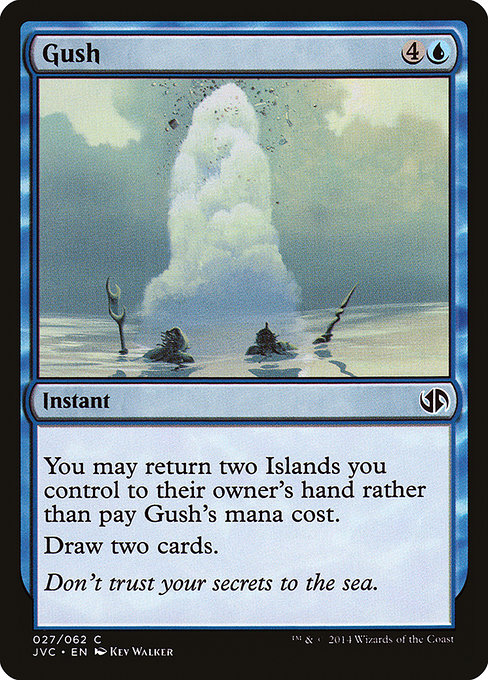
Image courtesy of Scryfall.com
Gush and the Evolution of MTG Storytelling
Magic: The Gathering’s storytelling has evolved in both scope and texture, moving from the tight, flavor-text-driven rooms of early sets to the expansive, cross-block sagas we follow today. At first glance, Gush is a simple blue instant with a powerful tempo twist: you may return two Islands you control to your hand to pay its mana cost, then draw two cards. But look closer, and the card becomes a window into how the game’s narrative language shifted over time—from atmospheric hints to interconnected, long-form storytelling that threads through sets, planes, and arcs 🧙🔥💎.
Oracle text: You may return two Islands you control to their owner's hand rather than pay this spell's mana cost. Draw two cards.
In the old guard of flavor, flavor text and art served as the primary conduits for world-building. Gush’s line, “Don’t trust your secrets to the sea.”, is emblematic of that era’s flavor approach: a compact whisper that implies a larger sea-sprung mythology. It invites enchantment and mystery without spelling out a grand prophecy. The card’s art—an evocative blue tableau by Kev Walker—works in tandem with the flavor tip to conjure a mood: a coastline where memory and deception run deeper than water. The synergy between image, flavor, and mechanic created a tactile sense of a living world you could glimpse but not fully own within a single card. That’s nostalgia with a purpose 🎨⚔️.
“Don’t trust your secrets to the sea.”
Fast-forward to modern MTG storytelling, and you’ll notice a shift toward multi-card narratives that weave through adventures, timelines, and crossroads of characters and planes. The Duel Decks Anthology: Jace vs. Chandra, which hosts Gush in a reprint, is a microcosm of that shift. The set pairs two iconic minds in a curated, story-forward package, using the card layout and accompanying lore to thread a conversation about how knowledge, risk, and power intersect. The old-world whisper of a flavor text has grown into a chorus of interconnected stories—yet Gush remains a charming relic that reminds us of the game’s earlier, purer whispers while still fitting neatly into modern control archetypes 🧙🔥🎲.
Mechanics as narrative devices
Gush’s mana cost and alternate-pay option anchor it firmly in blue’s wheelhouse: card advantage and tempo. The ability to return two Islands instead of paying mana cost can create a dramatic turn-by-turn arc—you deny mana payments with one hand while drawing two with the other. This tension between resource denial and resource expansion is a narrative beat in its own right: it asks you to weigh tempo against potential overextension, to read the board as a living story and decide what kind of author you want to be in that moment 🧠💎.
From a design perspective, the card’s set identity—Duel Decks Anthology: Jace vs. Chandra (JVC), released in 2014—anchors its flavor inside a focused duel-deck framework. The set’s premise is a clash of intellect and power, and Gush embodies blue’s obsession with information and momentum. Its common rarity belies how the effect can tilt a game toward a decisive narrative swing: a single turn where two new cards redraw the map of what’s possible, after you’ve shuffled away a portion of your mana base, like flipping a page to reveal a new chapter 🧭⚡.
- Tempo and card advantage: Gush trades mana efficiency for card draw, turning a cost into an opportunity to accelerate your plan.
- Islands as resource and risk: The card rewards a mana-denser weather system—blue’s preferred landscape—where Islands become both fuel and liability depending on the board state.
- Story through mechanics: While not a lore-drama engine, the card’s function hints at the sea’s capricious guardianship of secrets—the perfect thematic pair for a clash between Jace’s precision and Chandra’s daring.
- Format and flavor resonance: In formats where blue decks contest for control and card advantage, Gush continues to echo the old-school design ethos even as players celebrate modern storytelling frameworks across many sets.
Beyond the mechanics, Gush’s flavor text and era remind us how the game’s storytelling delivered flavor almost as a sidecar to play. In contemporary MTG, narratives are often anchored in ongoing story arcs, cross-block references, and multimedia storytelling. Yet the card’s quiet line still invites interpretation—the sea as keeper of secrets, the island as a sanctuary of memory, and the mind’s thirst for two fresh perspectives in a single breath of blue mana 🧙♀️🎨.
Nostalgia, collectibility, and the modern collector’s eye
Gush sits as a reprinted common in a celebrated duel deck, which means it’s accessible for players returning to the game and for collectors who love the card’s historical flavor. Its price point, often hovering in the two-dollar range on public markets, testifies to its enduring utility and nostalgic appeal; it’s not a mythic chase piece, but it’s undeniably a cherished window into how blue’s strategy evolved alongside its storytelling. Its journey—from flavor text whispers to a story-forward, card-driven moment—captures the heartbeat of MTG’s growth: a game that treats narrative as a guiding force, yet never forgets that the next draw can rewrite the scene 💎⚔️.
And if you’re building a weekend-long storytelling marathon around your desk—deck building, reading up on lore threads, and reliving classic control sequences—you’ll want to protect not just your cards but your gear. That’s where a modern companion accessory can help, pairing your nostalgia-fueled play with smart, stylish protection. The Neon Slim Phone Case for iPhone 16 offers a pop of color and durability to keep your tech as sharp as your mind during long nights of deckbuilding and lore-rambling.